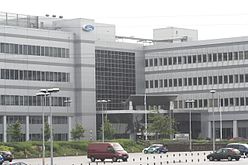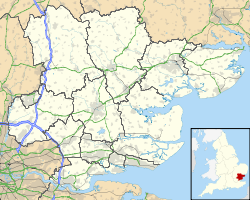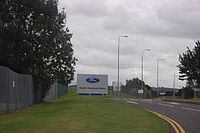- Dunton Technical Centre
-
Dunton Technical Centre Ford Dunton 
View from the frontFormer names Ford Research & Engineering Centre General information Type Automobile Research Centre Address Dunton, Laindon, Essex, SS15 6EE Coordinates 51°34′52″N 0°24′18″E / 51.581°N 0.405°E Elevation 45 m (148 ft) Current tenants Ford design team Completed 1 January 1967 Inaugurated 12 October 1967[1] Cost £10.5 million.[1] Technical details Other dimensions 268 acres (108.4 ha) Floor count 4 Design and construction Client Ford of Britain Landlord Ford of Europe Main contractor George Wimpey Services engineer G.N. Haden & Sons The Dunton Technical Centre (informally Ford Dunton) is a major automotive research and development facility located in Dunton, Laindon, United Kingdom owned and operated by Ford Motor Company. It is the largest automotive technical centre in the United Kingdom and takes its name from nearby Dunton Wayletts.[1] It houses the main design team of Ford of Europe, alongside its Merkenich Technical Centre in Cologne, Germany. Around 3,000 staff currently work at the site.[2]
Contents
Location
Ford Dunton is situated at the junction of West Mayne (B148) and the A127 Southend Arterial Road, in the district of Basildon. An electricity pylon line straddles the site. In front of the building, to the north, is a vehicle test track. To the south is the Southfields Business Park. The site lies in the religious parish of Laindon with Dunton, formerly in Dunton and Bulphan before 1976. Dunton is a small hamlet to the west, with a former church near Dunton Hall. There is a Ford dealership on the B148 on the north-west corner of the site.
History
Construction
Ford Dunton was constructed by George Wimpey, with their contract costing £6.5 million. When the Engineering and Styling Centre was built it was the largest engineering research centre in Europe. It was expected to cost around £10 million. Another development site at Aveley had been opened in 1956 which made prototype cars and spare parts, and closed in 2004[3]. Ford's earlier UK design site was at Birmingham, and it previously had seven engineering sites around the UK, with five in Essex; these all moved to Dunton. In the USA development work is done at the Dearborn Development Center in Michigan, home of Ford.
The centre was opened by Harold Wilson, then the Prime Minister, on 12 October 1967.[2] The Managing Director of Ford at the time was Leonard Crossland.
Ford of Europe
When Ford of Europe was formed, responsibility for design and development of passenger cars was redistributed as follows. Dunton handled vehicle design, interior styling, chassis and body interior engineering, engine calibration and product planning. The Cologne Merkenich Centre was given principal responsibility for body and electrical engineering, base engine design plus advanced engine development, exterior styling (design), homologation, vehicle development (ride, handling, NVH) and transmission engineering. This was a 'systems' approach to the engineering process which eliminated any duplication of the engineering responsibility within Europe. Originally the Dunton site had 45,000 sq ft (4,200 m2) for design work. In the early 1970s Ford had 21 plants across the UK. In 1970 Ford also bought the Carrozzeria Ghia design company in Turin, Italy.
On 10 May 1971 Peter Walker opened a £1 million engine emissions laboratory, the largest of its type in Europe. In November 1974 it opened the world's first automated (computerised) multiple engine (six) test bed. It was built in co-operation with the engineering drocessepartment of Queen Mary, University of London. Previously engine research was carried out manually.
The computer age
In 1974 it installed a Honeywell 6050 computer at a cost of £820,000. It was linked to Merkenich, and the test track at Lommel in Belgium. In 1978 it had access to a CDC Cyber 176 computer at the USA base in Dearborn.
By 1984 they were video-conferencing with colleagues at Merkenich, using the ECS-1 satellite, and enabled by British Telecom International, who developed video codecs at their laboratories (BT Research) at Adastral Park, Martlesham in Suffolk.
In 1988 it prepared the way for design of the Mondeo (codename CDW27) by pioneering, with Merkenich, the World Engineering Release System (WERS). Dunton at this time was the most advanced automotive development centre in Europe.
On 16 December 1997 Alexander Trotman, Baron Trotman opened a £128 million environmental engine testing facility at Dunton.[4]
In 2003 it built a Silicon Graphics International (SGI) Reality Centre, with SGI Onyx 3000 visualisation supercomputers, using the InfiniteReality3 graphics rendering system.
In March 2010 Ford announced plans to develop a new generation of environmentally friendly engines and vehicle technologies at Dunton following an announcement by the UK Government that it would underwrite £360 million of a £450 million loan to Ford from the European Investment Bank.[5] In July 2010 the new coalition government confirmed that it would honour the loan commitment, and the contract was signed in a ceremony at Dunton attended by the business minister Mark Prisk on 12 July.[6]
Development work
In the 1960s Dunton worked on an experimental electric car, first shown on 7 June 1967, and called the Ford Comuta.[7]
In 1995 Ford Dunton, in collaboration with the University of Southampton, developed a device which is capable of detecting different types of plastic (for recycling) using the triboelectric effect, including polypropylene, polyethylene, nylon and acrylonitrile butadiene styrene (ABS).
Ford Dunton is the home of Ford Team RS, and as part of the Special Vehicle section of Ford, developed the XR family of 'boy racer' vehicles with the Ford Fiesta RS Turbo, more recently becoming the RS family of vehicles. Ford also notably worked in this area of design with Cosworth of Northampton.
Recently Ford Dunton has developed the ECOnetic range of vehicles, and contributed to development of the EcoBoost range of engines.
Activities
Dunton houses the main design team of Ford of Europe, alongside its Merkenich Technical Centre in Cologne (Ford of Europe is headquartered in Germany, Ford in the UK is headquartered at Warley, Essex, south of Brentwood).
Dunton designs the Ford Fiesta, the Ford Ka, engines for Ford of Europe (powertrain), and commercial vehicles. Dunton has also has responsibility for the interior of Ford of Europe cars. It has facilities to simultaneously test fifteen cars and around one hundred engines. It is claimed to have the world's largest anechoic chamber.
Around 3,000 engineers currently work at Dunton.
Notable staff
- Eamonn Martin, 1993 London Marathon winner
See also
- Whitley plant - was also owned by Ford
- National Engineering Laboratory
- Transport Research Laboratory
References
- ^ a b c "Back to the future for Ford". The Engineer. 26 October 2007. http://www.theengineer.co.uk/news/back-to-the-future-for-ford/302785.article. Retrieved 7 June 2011.
- ^ a b "Ford Dunton turns 40". Daily Gazette. 13 October 2007. http://www.gazette-news.co.uk/news/1754626.ford_dunton_turns_40/. Retrieved 7 June 2011.
- ^ Aveley site closes in 2004
- ^ "Motorists face fines for dirty fumes". BBC News. 16 December 1997. http://news.bbc.co.uk/1/hi/uk/39990.stm. Retrieved 7 June 2011.
- ^ "Jobs safeguarded at Ford in Essex". Essex County Standard. 18 March 2010. http://www.essexcountystandard.co.uk/news/localnews/5067894.Jobs_safeguarded_at_Ford_in_Essex/. Retrieved 7 June 2011.
- ^ "Coalition to honour £360m loan to Ford Dunton". Basildon Recorder. 13 July 2010. http://www.basildonrecorder.co.uk/news/echo/8268255.Coalition_to_honour___360m_loan_to_Ford_Dunton/. Retrieved 7 June 2011.
- ^ "Battery-car progress - at 8 mile an hour in 25 years". New Scientist. 9 December 1971. http://books.google.co.uk/books?id=lAkQhbgpkpIC&pg=PA91&dq=Ford+Comuta+dunton&hl=en&ei=GHvtTcDACIGa8QPstoG-Bw&sa=X&oi=book_result&ct=result&resnum=3&ved=0CDYQ6AEwAg#v=onepage&q=Ford%20Comuta%20dunton&f=false. Retrieved 7 June 2011.
External links
Video clips
- Environmental Test Laboratory
- University of Cambridge solar powered vehicle built by Cambridge University Eco Racing
News items
Ford of Europe Ford Motor Company Divisions and
subsidiariesCurrentDefunctFacilities CurrentAutomobile Craiova · Bridgend Engine · Cologne Body & Assembly · Dagenham Plant · Dunton Technical Centre · Genk Body & Assembly · Lommel Proving Grounds · Merkenich Technical Centre · Otosan Assembly · Saarlouis Body & Assembly · Southampton Body & Assembly · Valencia Plant · Vsevolozhsk AssemblyFormerPassenger cars CurrentPastCommercial vehicles MinibusesTrucks (defunct)VansCurrentPast CategoryCategories:
CategoryCategories:- Ford of Europe
- Buildings and structures in Essex
- 1967 establishments in England
- Buildings and structures completed in 1967
- Road test tracks
- Basildon
- Automotive engineering
- Engine technology
- Ford vehicle design
- Engineering research institutes
- Research and development in the United Kingdom
Wikimedia Foundation. 2010.


